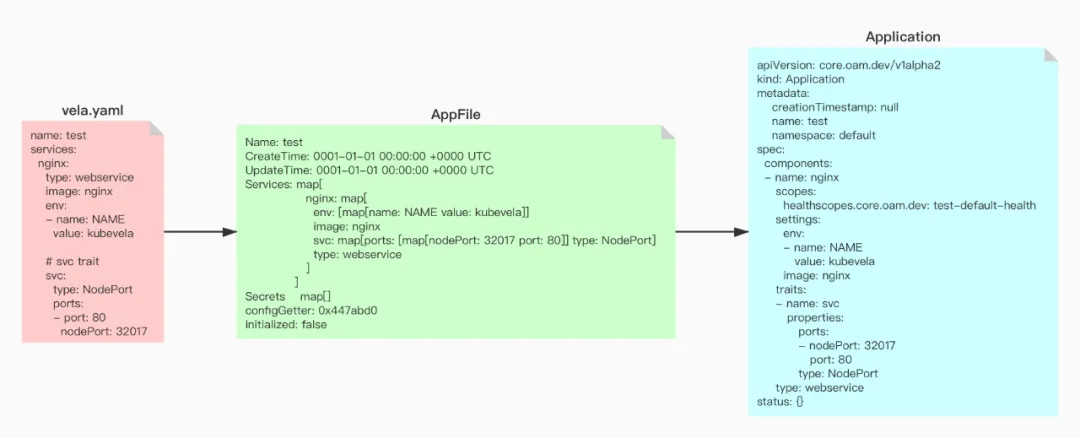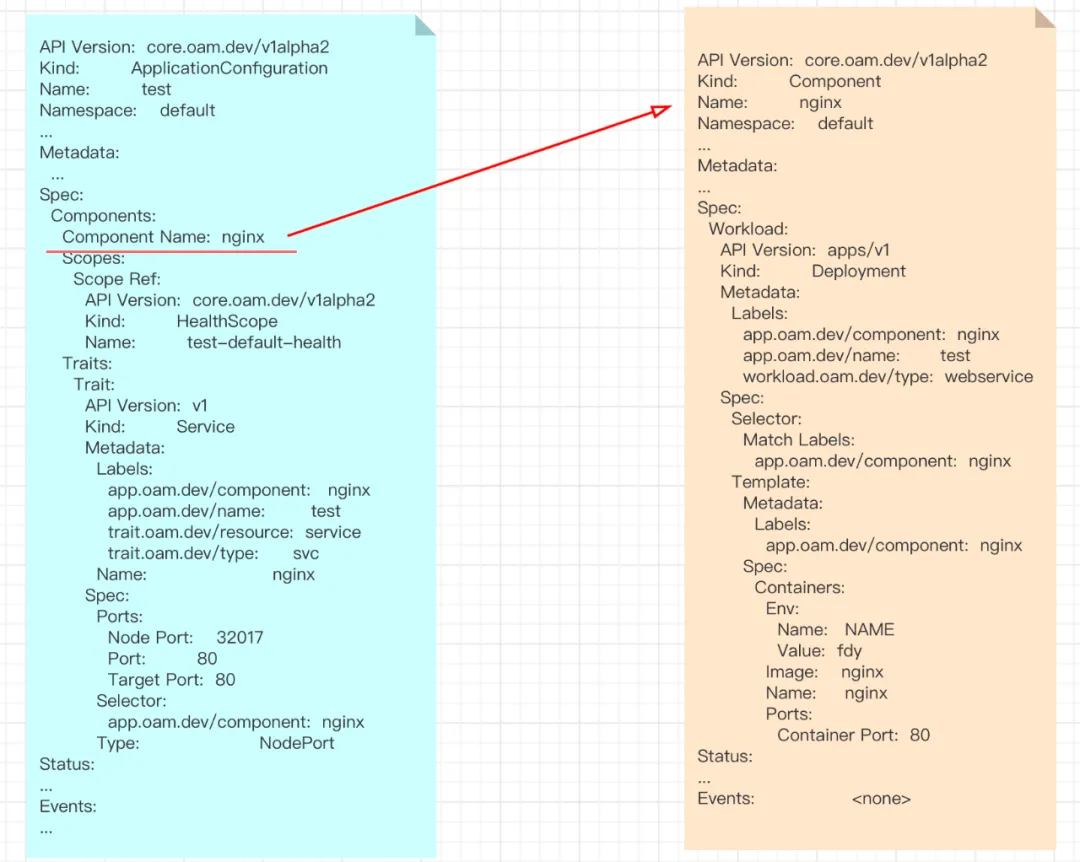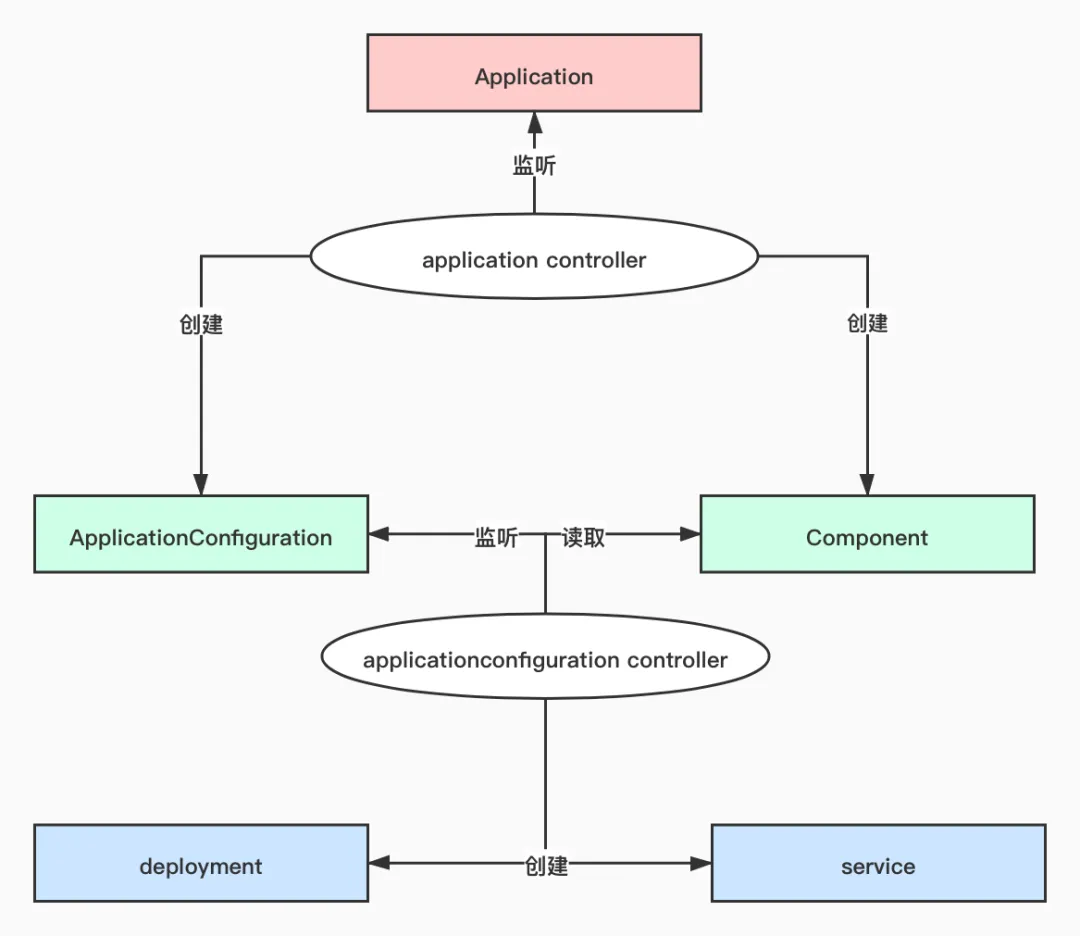您好,登錄后才能下訂單哦!
您好,登錄后才能下訂單哦!
這期內容當中小編將會給大家帶來有關KubeVela是如何將appfile轉換為K8s特定資源對象的,文章內容豐富且以專業的角度為大家分析和敘述,閱讀完這篇文章希望大家可以有所收獲。
KubeVela 是一個簡單易用又高度可擴展的云原生應用管理引擎,是基于 Kubernetes 及阿里云與微軟云共同發布的云原生應用開發模型 OAM 構建。
KubeVela 基于 OAM 模型構建了一套具體的實現,通過 Golang 編寫,可以端到端地為用戶構建云原生應用的平臺,提供一個相對完整的解決方案。
下面主要目的是探索 KubeVela 如何將一個 appfile 文件轉換為 K8s 中特定的資源對象。
該過程總的來說分為兩個階段:
appfile 轉為 K8s 中的 application
application 轉換為對應的 K8s 資源對象
# vela.yaml name: test services: nginx: type: webservice image: nginx env: - name: NAME value: kubevela # svc trait svc: type: NodePort ports: - port: 80 nodePort: 32017
利用 vela up 命令可以完成部署。
建議:在看 vela 命令行工具代碼之前,先去簡單了解一下 cobra 框架。
// references/cli/up.go
// NewUpCommand will create command for applying an AppFile
func NewUpCommand(c types.Args, ioStream cmdutil.IOStreams) *cobra.Command {
cmd := &cobra.Command{
Use: "up",
DisableFlagsInUseLine: true,
Short: "Apply an appfile",
Long: "Apply an appfile",
Annotations: map[string]string{
types.TagCommandType: types.TypeStart,
},
PersistentPreRunE: func(cmd *cobra.Command, args []string) error {
return c.SetConfig()
},
RunE: func(cmd *cobra.Command, args []string) error {
velaEnv, err := GetEnv(cmd)
if err != nil {
return err
}
kubecli, err := c.GetClient()
if err != nil {
return err
}
o := &common.AppfileOptions{
Kubecli: kubecli,
IO: ioStream,
Env: velaEnv,
}
filePath, err := cmd.Flags().GetString(appFilePath)
if err != nil {
return err
}
return o.Run(filePath, velaEnv.Namespace, c)
},
}
cmd.SetOut(ioStream.Out)
cmd.Flags().StringP(appFilePath, "f", "", "specify file path for appfile")
return cmd
}上面源碼展示的是 vela up 命令的入口。
在 PresistentPreRunE 函數中,通過調用 c.SetConfig() 完成 Kuberentes 配置信息 kubeconfig 的注入。
在 RunE 函數中:
首先,獲取 vela 的 env 變量,velaEnv.Namespace 對應 Kubernetes 的命名空間。
其次,獲取 Kubernetes 的客戶端,kubectl。
接著,利用 Kubernetes 客戶端和 vleaEnv 來構建渲染 Appfile 需要的 AppfileOptions。
最后,調用 o.Run(filePath, velaEnv.Namespace, c)。
filePath: appfile 的路徑
velaEnv.Namespace:對應 K8s 的 namespace
c:K8s 客戶端
該函數需要三個參數,其中 filePath 用于指定 appfile 的位置,velaEnv.Namespace 和 c 用來將渲染后的 Application 創建到指定命名空間。
起點:appfile
終點:applicatioin
路徑:appfile -> application (services -> component)
comp[workload, traits]
// references/appfile/api/appfile.go
// AppFile defines the spec of KubeVela Appfile
type AppFile struct {
Name string `json:"name"`
CreateTime time.Time `json:"createTime,omitempty"`
UpdateTime time.Time `json:"updateTime,omitempty"`
Services map[string]Service `json:"services"`
Secrets map[string]string `json:"secrets,omitempty"`
configGetter config.Store
initialized bool
}
// NewAppFile init an empty AppFile struct
func NewAppFile() *AppFile {
return &AppFile{
Services: make(map[string]Service),
Secrets: make(map[string]string),
configGetter: &config.Local{},
}
}// references/appfile/api/service.go
// Service defines the service spec for AppFile, it will contain all related information including OAM component, traits, source to image, etc...
type Service map[string]interface{}上面兩段代碼是 AppFile 在客戶端的聲明,vela 會將指定路徑的 yaml 文件讀取后,賦值給一個 AppFile。
// references/appfile/api/appfile.go
// LoadFromFile will read the file and load the AppFile struct
func LoadFromFile(filename string) (*AppFile, error) {
b, err := ioutil.ReadFile(filepath.Clean(filename))
if err != nil {
return nil, err
}
af := NewAppFile()
// Add JSON format appfile support
ext := filepath.Ext(filename)
switch ext {
case ".yaml", ".yml":
err = yaml.Unmarshal(b, af)
case ".json":
af, err = JSONToYaml(b, af)
default:
if json.Valid(b) {
af, err = JSONToYaml(b, af)
} else {
err = yaml.Unmarshal(b, af)
}
}
if err != nil {
return nil, err
}
return af, nil
}下面為讀取 vela.yaml 文件后,加載到 AppFile 中的數據:
# vela.yaml name: test services: nginx: type: webservice image: nginx env: - name: NAME value: kubevela # svc trait svc: type: NodePort ports: - port: 80 nodePort: 32017
Name: test CreateTime: 0001-01-01 00:00:00 +0000 UTC UpdateTime: 0001-01-01 00:00:00 +0000 UTC Services: map[ nginx: map[ env: [map[name: NAME value: kubevela]] image: nginx svc: map[ports: [map[nodePort: 32017 port: 80]] type: NodePort] type: webservice ] ] Secrets map[] configGetter: 0x447abd0 initialized: false
// apis/core.oam.dev/application_types.go
type Application struct {
metav1.TypeMeta `json:",inline"`
metav1.ObjectMeta `json:"metadata,omitempty"`
Spec ApplicationSpec `json:"spec,omitempty"`
Status AppStatus `json:"status,omitempty"`
}
// ApplicationSpec is the spec of Application
type ApplicationSpec struct {
Components []ApplicationComponent `json:"components"`
// TODO(wonderflow): we should have application level scopes supported here
// RolloutPlan is the details on how to rollout the resources
// The controller simply replace the old resources with the new one if there is no rollout plan involved
// +optional
RolloutPlan *v1alpha1.RolloutPlan `json:"rolloutPlan,omitempty"`
}上面代碼,為 Application 的聲明,結合 .vela/deploy.yaml(見下面代碼),可以看出,要將一個 AppFile 渲染為 Application 主要就是將 AppFile 的 Services 轉化為 Application 的 Components。
# .vela/deploy.yaml
apiVersion: core.oam.dev/v1alpha2
kind: Application
metadata:
creationTimestamp: null
name: test
namespace: default
spec:
components:
- name: nginx
scopes:
healthscopes.core.oam.dev: test-default-health
settings:
env:
- name: NAME
value: kubevela
image: nginx
traits:
- name: svc
properties:
ports:
- nodePort: 32017
port: 80
type: NodePort
type: webservice
status: {}結合以上內容可以看出,將 Appfile 轉化為 Application 主要是將 Services 渲染為 Components。
// references/appfile/api/appfile.go
// BuildOAMApplication renders Appfile into Application, Scopes and other K8s Resources.
func (app *AppFile) BuildOAMApplication(env *types.EnvMeta, io cmdutil.IOStreams, tm template.Manager, silence bool) (*v1alpha2.Application, []oam.Object, error) {
...
servApp := new(v1alpha2.Application)
servApp.SetNamespace(env.Namespace)
servApp.SetName(app.Name)
servApp.Spec.Components = []v1alpha2.ApplicationComponent{}
for serviceName, svc := range app.GetServices() {
...
// 完成 Service 到 Component 的轉化
comp, err := svc.RenderServiceToApplicationComponent(tm, serviceName)
if err != nil {
return nil, nil, err
}
servApp.Spec.Components = append(servApp.Spec.Components, comp)
}
servApp.SetGroupVersionKind(v1alpha2.SchemeGroupVersion.WithKind("Application"))
auxiliaryObjects = append(auxiliaryObjects, addDefaultHealthScopeToApplication(servApp))
return servApp, auxiliaryObjects, nil
}上面的代碼是 vela 將 Appfile 轉化為 Application 代碼實現的位置。其中 comp, err := svc.RenderServiceToApplicationComponent(tm, serviceName) 完成 Service 到 Component 的轉化。
// references/appfile/api/service.go
// RenderServiceToApplicationComponent render all capabilities of a service to CUE values to KubeVela Application.
func (s Service) RenderServiceToApplicationComponent(tm template.Manager, serviceName string) (v1alpha2.ApplicationComponent, error) {
// sort out configs by workload/trait
workloadKeys := map[string]interface{}{}
var traits []v1alpha2.ApplicationTrait
wtype := s.GetType()
comp := v1alpha2.ApplicationComponent{
Name: serviceName,
WorkloadType: wtype,
}
for k, v := range s.GetApplicationConfig() {
// 判斷是否為 trait
if tm.IsTrait(k) {
trait := v1alpha2.ApplicationTrait{
Name: k,
}
....
// 如果是 triat 加入 traits 中
traits = append(traits, trait)
continue
}
workloadKeys[k] = v
}
// Handle workloadKeys to settings
settings := &runtime.RawExte nsion{}
pt, err := json.Marshal(workloadKeys)
if err != nil {
return comp, err
}
if err := settings.UnmarshalJSON(pt); err != nil {
return comp, err
}
comp.Settings = *settings
if len(traits) > 0 {
comp.Traits = traits
}
return comp, nil
}執行 vela up 命令,渲染 appfile 為 Application,將數據寫入到 .vela/deploy.yaml 中,并在 K8s 中創建。

起點:Application
中點:ApplicationConfiguration, Component
終點:Deployment, Service
路徑:
application_controller
applicationconfiguration controller
【建議】> 了解一下內容:> - client-to
controller-runtime
operator
# 獲取集群中的 Application $ kubectl get application NAMESPACE NAME AGE default test 24h
當 application controller 獲取到 Application 資源對象之后,會根據其內容創建出對應的 ApplicationConfiguration 和 Component。
# 獲取 ApplicationConfiguration 和 Component $ kubectl get ApplicationConfiguration,Component NAME AGE applicationconfiguration.core.oam.dev/test 24h NAME WORKLOAD-KIND AGE component.core.oam.dev/nginx Deployment 24h
ApplicationiConfiguration 中以名字的方式引入 Component:

獲取一個 Application 資源對象。
將 Application 資源對象渲染為 ApplicationConfiguration 和 Component。
創建 ApplicationConfiguration 和 Component 資源對象。
// pkg/controller/core.oam.dev/v1alpha2/application/application_controller.go
// Reconcile process app event
func (r *Reconciler) Reconcile(req ctrl.Request) (ctrl.Result, error) {
ctx := context.Background()
applog := r.Log.WithValues("application", req.NamespacedName)
// 1. 獲取 Application
app := new(v1alpha2.Application)
if err := r.Get(ctx, client.ObjectKey{
Name: req.Name,
Namespace: req.Namespace,
}, app); err != nil {
...
}
...
// 2. 將 Application 轉換為 ApplicationConfiguration 和 Component
handler := &appHandler{r, app, applog}
...
appParser := appfile.NewApplicationParser(r.Client, r.dm)
...
appfile, err := appParser.GenerateAppFile(ctx, app.Name, app)
...
ac, comps, err := appParser.GenerateApplicationConfiguration(appfile, app.Namespace)
...
// 3. 在集群中創建 ApplicationConfiguration 和 Component
// apply appConfig & component to the cluster
if err := handler.apply(ctx, ac, comps); err != nil {
applog.Error(err, "[Handle apply]")
app.Status.SetConditions(errorCondition("Applied", err))
return handler.handleErr(err)
}
...
return ctrl.Result{}, r.UpdateStatus(ctx, app)
}獲取 ApplicationConfiguration 資源對象。
循環遍歷,獲取每一個 Component 并將 workload 和 trait 渲染為對應的 K8s 資源對象。
創建對應的 K8s 資源對象。
// pkg/controller/core.oam.dev/v1alpha2/applicationcinfiguratioin/applicationconfiguratioin.go
// Reconcile an OAM ApplicationConfigurations by rendering and instantiating its
// Components and Traits.
func (r *OAMApplicationReconciler) Reconcile(req reconcile.Request) (reconcile.Result, error) {
...
ac := &v1alpha2.ApplicationConfiguration{}
// 1. 獲取 ApplicationConfiguration
if err := r.client.Get(ctx, req.NamespacedName, ac); err != nil {
...
}
return r.ACReconcile(ctx, ac, log)
}
// ACReconcile contains all the reconcile logic of an AC, it can be used by other controller
func (r *OAMApplicationReconciler) ACReconcile(ctx context.Context, ac *v1alpha2.ApplicationConfiguration,
log logging.Logger) (result reconcile.Result, returnErr error) {
...
// 2. 渲染
// 此處 workloads 包含所有Component對應的的 workload 和 tratis 的 k8s 資源對象
workloads, depStatus, err := r.components.Render(ctx, ac)
...
applyOpts := []apply.ApplyOption{apply.MustBeControllableBy(ac.GetUID()), applyOnceOnly(ac, r.applyOnceOnlyMode, log)}
// 3. 創建 workload 和 traits 對應的 k8s 資源對象
if err := r.workloads.Apply(ctx, ac.Status.Workloads, workloads, applyOpts...); err != nil {
...
}
...
// the defer function will do the final status update
return reconcile.Result{RequeueAfter: waitTime}, nil
}當 vela up 將一個 AppFile 渲染為一個 Application 后,后續的流程由 application controller 和 applicationconfiguration controller 完成。

上述就是小編為大家分享的KubeVela是如何將appfile轉換為K8s特定資源對象的了,如果剛好有類似的疑惑,不妨參照上述分析進行理解。如果想知道更多相關知識,歡迎關注億速云行業資訊頻道。
免責聲明:本站發布的內容(圖片、視頻和文字)以原創、轉載和分享為主,文章觀點不代表本網站立場,如果涉及侵權請聯系站長郵箱:is@yisu.com進行舉報,并提供相關證據,一經查實,將立刻刪除涉嫌侵權內容。